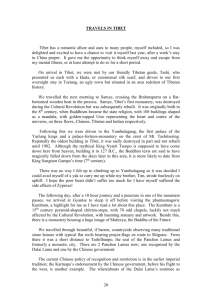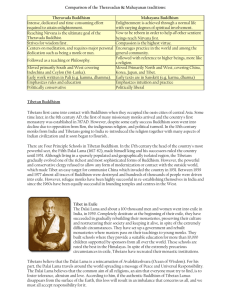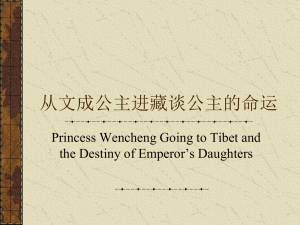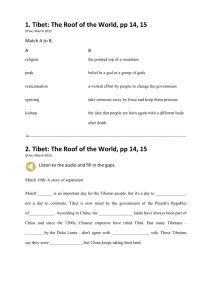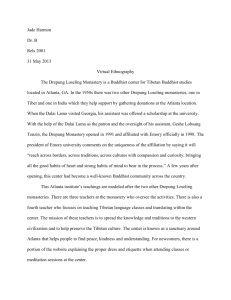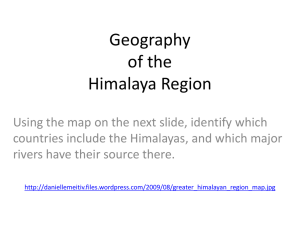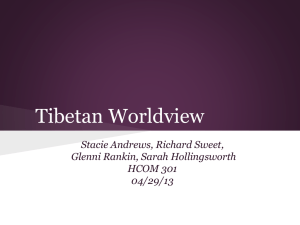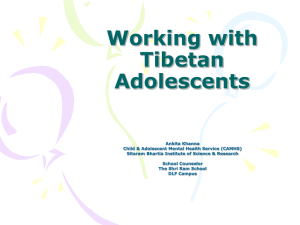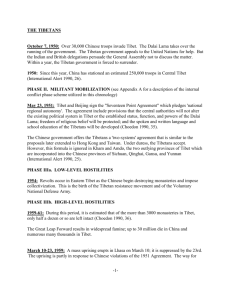04 A Tibetan Adventure - Phils Articles about China, Tibet and
advertisement
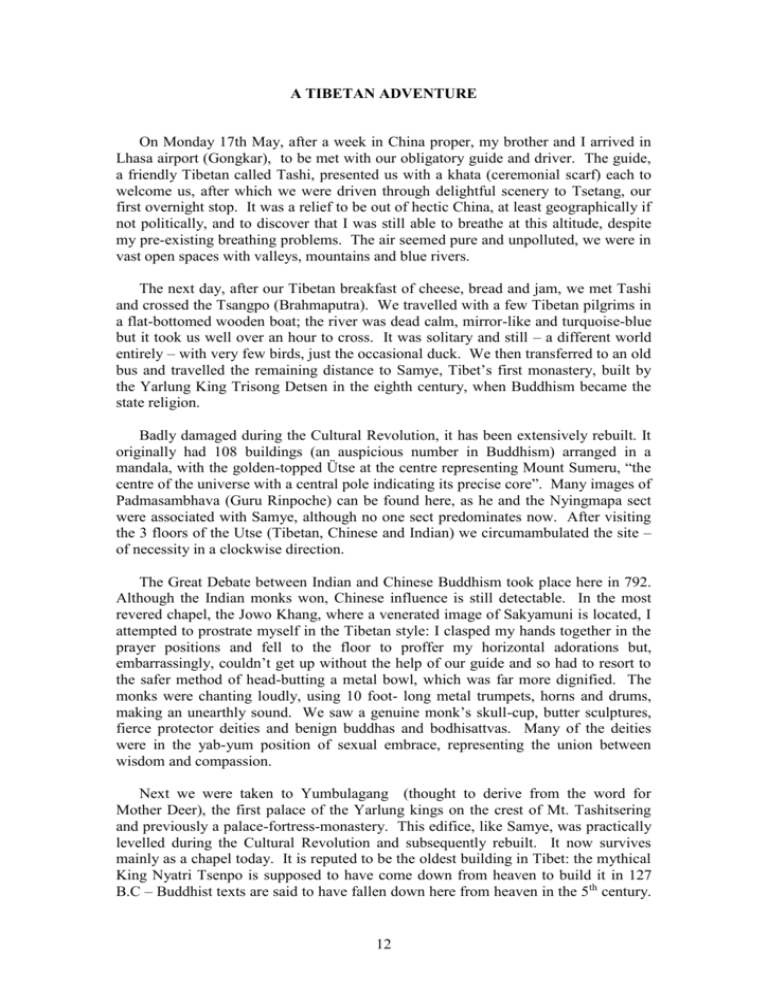
A TIBETAN ADVENTURE On Monday 17th May, after a week in China proper, my brother and I arrived in Lhasa airport (Gongkar), to be met with our obligatory guide and driver. The guide, a friendly Tibetan called Tashi, presented us with a khata (ceremonial scarf) each to welcome us, after which we were driven through delightful scenery to Tsetang, our first overnight stop. It was a relief to be out of hectic China, at least geographically if not politically, and to discover that I was still able to breathe at this altitude, despite my pre-existing breathing problems. The air seemed pure and unpolluted, we were in vast open spaces with valleys, mountains and blue rivers. The next day, after our Tibetan breakfast of cheese, bread and jam, we met Tashi and crossed the Tsangpo (Brahmaputra). We travelled with a few Tibetan pilgrims in a flat-bottomed wooden boat; the river was dead calm, mirror-like and turquoise-blue but it took us well over an hour to cross. It was solitary and still – a different world entirely – with very few birds, just the occasional duck. We then transferred to an old bus and travelled the remaining distance to Samye, Tibet’s first monastery, built by the Yarlung King Trisong Detsen in the eighth century, when Buddhism became the state religion. Badly damaged during the Cultural Revolution, it has been extensively rebuilt. It originally had 108 buildings (an auspicious number in Buddhism) arranged in a mandala, with the golden-topped Ütse at the centre representing Mount Sumeru, “the centre of the universe with a central pole indicating its precise core”. Many images of Padmasambhava (Guru Rinpoche) can be found here, as he and the Nyingmapa sect were associated with Samye, although no one sect predominates now. After visiting the 3 floors of the Utse (Tibetan, Chinese and Indian) we circumambulated the site – of necessity in a clockwise direction. The Great Debate between Indian and Chinese Buddhism took place here in 792. Although the Indian monks won, Chinese influence is still detectable. In the most revered chapel, the Jowo Khang, where a venerated image of Sakyamuni is located, I attempted to prostrate myself in the Tibetan style: I clasped my hands together in the prayer positions and fell to the floor to proffer my horizontal adorations but, embarrassingly, couldn’t get up without the help of our guide and so had to resort to the safer method of head-butting a metal bowl, which was far more dignified. The monks were chanting loudly, using 10 foot- long metal trumpets, horns and drums, making an unearthly sound. We saw a genuine monk’s skull-cup, butter sculptures, fierce protector deities and benign buddhas and bodhisattvas. Many of the deities were in the yab-yum position of sexual embrace, representing the union between wisdom and compassion. Next we were taken to Yumbulagang (thought to derive from the word for Mother Deer), the first palace of the Yarlung kings on the crest of Mt. Tashitsering and previously a palace-fortress-monastery. This edifice, like Samye, was practically levelled during the Cultural Revolution and subsequently rebuilt. It now survives mainly as a chapel today. It is reputed to be the oldest building in Tibet: the mythical King Nyatri Tsenpo is supposed to have come down from heaven to build it in 127 B.C – Buddhist texts are said to have fallen down here from heaven in the 5th century. 12 In reality, it probably dates from King Songtsen Gampo’s days two centuries later. Although the new building only dates from 1982, it still retains an attraction. There was no way I felt up to climbing up to Yumbulagang, so it was decided I could avail myself of a yak to carry me up while Tim strode fearlessly on uphill. The building contains chapels on 2 levels, a statue of Avalokitesvara/Chenresig and some impressive murals. The poor yak was completely exhausted with my 14 ¾ stone burden – I hope the poor beast didn’t suffer too much but I rather suspect he did. I got to know yaks inside and out in Tibet. I ate them regularly for meals, yakburgers etc. and they were everywhere to be seen. Wed. 19th We travelled for 10 hours, passing along a turquoise lake (130 kilometres long and up to 70 metres deep). We started on a tarmac road, then a sand road, followed by a road under construction for hours (100 kilometres), went up and around several mountains up to a 4,600m pass in the morning, looking down on the lake despite the bad weather conditions before driving into a small settlement, to a café which had “the best food in town”. Tim thought it seemed like a Star Wars aliens’ café; the food was edible, if rather expensive, but naturally the standards were very low compared to the West. There were a few Western travellers here looking wretched and exhausted, obviously with altitude sickness. I tried the local toilet and was charged one yuan to share a filthy room with 2 Japanese ladies visibly dumping in open holes whilst I urinated merrily away to their evident concern and embarrassment. After this brief diversion we continued the drive on to a higher pass near the top of a snow-capped mountain. The roads were slushy narrow tracks with deep ditches and a steep drop. We had a puncture near the top of the 2nd pass after being besieged by locals trying to sell polished stones and necklaces, (and grabbing as many of my cigarettes as they could), with yaks pulling ploughs on tiny pockets of flat land 5,000 m. high. I loved smoking at this heady altitude – my only remaining ambition now is to smoke at the top of Everest. Eventually we arrived in Gyantse to sleep it off. The highlight of Gyantse for me was definitely the Kumbum (literally 100,000 images) a 15th century pyramid-shaped chörten (stupa) with 70 odd chapels. The artwork by Newari craftsmen is exclusively Tibetan. We went up through all the levels permitted, but could not gain access to the 9th storey which I was particularly keen on seeing because there is a gilded copper image there of the top-dog Vajradhara Buddha, the embodiment of ultimate reality and the expression of the Buddhist Logos. The Kumbum reflects all the orders of Tibetan Buddhism and is an amazing extravaganza and phantasmagoria of beautiful and haunting artwork and deities. Luckily it was not much affected by the Cultural Revolution. Next door is a monastery housing a huge image of Maitreya (The Buddha of the Future). We looked at the 14th century dzong (fort or castle) which suffered serious damage during the British Younghusband expedition (in reality invasion) and also in the 60s and 70s. Afterwards we travelled on a proper road though beautiful countryside – it was extremely peaceful and there were many lovely traditional stone houses with typical flat roofs bearing prayer-flags - on to Shigatse. We viewed Tashilhunpo, just outside Shigatse, the seat of the Panchen Lamas – one of the largest monastery complexes in Tibet, a monastic city in fact. It was founded in 1447 by the nephew and follower of the reformed Gelugpa sect founder 13 Tsongkhapa. This follower, Gedundrub, was subsequently and retroactively called the First Dalai Lama. The Great Fifth Dalai Lama conferred the title of Panchen Lama in 1642 on Chokyi Gyaltsen who became the first incumbent (with a retroactive pseudo-lineage), becoming the second-ranking member of the Lamaist hierarchy (the 1st was of course the Dalai Lama, and 3rd was the Jebtsundamba Khutuktu of Mongolia). The Panchen Lamas were often manipulated by the Manchus and the Chinese after them still try to do this as a counterweight to the Dalais. To digress, the Manchus in the Qing dynasty both patronised and attempted to control Lamaism in Tibet and Mongolia. They may have believed in Lamaism themselves but they knew how to restrict and control it to their advantage. They built up a whole Lamaist centre in Beijing with at least 28, possibly 53 Lamaist monasteries and temples there; in addition, there were about 1000 Lamaist monks (mostly Mongols) during the 18th and 19th centuries in Beijing. Extensive Lamaist complexes were built in Jehol (Chengde), Shenyang, Wutaishan, Dolonnur and Huhehot with support from the Manchus, even within the Forbidden City, in 35 Lamaist chapels, where the monks prayed for the Emperor (spiritual opportunism?). They were courted, feted and salaried by the Qing while the incarnations of Tibet and Mongolia had to make periodic “tribute missions” to the capital. They had their own “Living Buddha” incarnation, the Changkya /Zhangjia Khutuktu, resident at Beijing to use in their cultural and ideological diplomacy and as counterweight to the incarnate pontiffs of Tibet and Mongolia. The emperors popularised themselves as incarnations of Manjusri, the bodhisattva of wisdom, in order to promote their spiritual legitimacy and imagined connection with Khubilai Khaan. There is a picture of Qianlong as Manjusri in the Potala. They aimed to oversee, regulate and restrict the unfettered growth of religion on the other hand. In the late 18th century they instituted the famous “Golden Urn Ceremony” whereby the major incarnations, including the top 3: the Dalai and Panchen Lamas and the Jebtsundamba Khutuktus were to be selected by lot from ivory tablets placed in a golden urn (usually 3) under the supervision of Manchu representatives either in Tibet (for the Dalai) or Beijing (in the Yong He Gong.). In practise it was not always used in Tibet e.g. the last 2 Dalais avoided it but Beijing’s recognition was always required in theory. To avoid strong conglomerations of spiritual and secular power in Mongolia, the Jebtsundambas had to come from Tibet by imperial decree from the 18th century. Therefore it is evident that the contemporary Chinese policy of restriction and recognition is within the earlier imperial tradition. The communist government made a big show of recognising the Karmapa lama recently, hoping to use it as a propaganda offensive, before his recent flight to India. It is challenging the Dalai Lama’s authority to select a Panchen Lama and has selected its own incumbent in opposition to the Dalai Lama’s choice. The difference is that whereas during the Qing, Tibet was de jure a protectorate of China as far as the Chinese were concerned, de facto it had quite a fair degree of autonomy, now Tibet is de facto a part of China. Back to Tashilhumpo. The Panchen Lamas are considered by some to be actually superior to the Dalai Lamas in spiritual rank, as the latter are incarnations of a bodhisattva (Avalokitesvara) whilst the Panchen Lamas are regarded as emanations of the Buddha Amitabha.. This is arguable because the devotion to Avalokitesvara in 14 Tibet is intense and both deities belong to the same Lotus Family. The original building of Tashilhunpo contains a 26 metre high statue of Jampa (Maitreya), the Future Buddha, built in 1914 by the 9th Panchen, for which 300kg. of gold and 150 tons of copper and brass were used: it is the largest gilded statue in the world. There are mausolea for the remains of previous Panchen Lamas including one for the 10th on which the Chinese government spent 7.75 million dollars; the walls are painted with real gold buddhas. As mentioned, there are 2 Panchen lamas now – one recognised by the Dalai Lama, one by the Chinese government. The former’s whereabouts are unknown but he is presumed to be under house-arrest somewhere, whereas the latter must be undergoing spiritual and political training before he is allowed to take up his residence at Tashilhunpo. Will there be 2 Dalai Lamas, when the present 14th incumbent dies? A disturbing possibility. Friday 21st May We left Shigatse, driving in the direction of Lhasa via mountain passes and saw from the car a sky burial: the traditional Tibetan practise of leaving the dead out high up to be devoured by vultures, possibly an echo of Zoroastrianism? We also observed a Bön monastery in the distance; although most Western writers cast aspersions on this indigenous religion, in fact it is not just shamanism or animism, but a highly developed and sophisticated religion. Admittedly it borrowed from Buddhism, but Buddhism also borrowed from it. Founded by a certain Shenrab (who as Shenrab Miwo became one of the 4 transcendent Lords of Bön), in a land called Tazig (obviously reminiscent of Tajik) in the West, a semi-paradisiacal land which may possibly be equated with Persia, it does seem to have Manichaean traces. Shenrab became a king, supposedly, of this area and Bön developed its own deities and incarnations. The counter-clockwise swastika (unlike the Buddhist clockwise version) is a Bön symbol of eternity. Likewise circumambulation in Bön monasteries is always in an anti-clockwise direction. A diversion meant that there would be an extra 130 kilometres to go (340 altogether). We crossed the first pass at 4700m, after which the wheel bearing needed repairing by the driver before we reached the next pass at 5,300m. where I had a lascivious smoke-break and we were pelted by snowballs. The road was blocked by a huge boulder, which we just managed to negotiate without dropping into the abyss. We proceeded to get stuck in a mountainous traffic jam which several vehicles (lorries, army vehicles, coaches) were in the same situation and consequently had a 2 hour wait. Eventually we turned the corner to find cars, Landcruisers and a lorry buried in the mud. Half a dozen of these were permanently stuck; we tried to get through but were stuck in deep mud ourselves until at last six Chinese helped to push us out. The shaky and bumpy road continued until eventually we reached a real road; half the journey had been on a mud road. After 11 hours on the road we arrived at Lhasa, “the home of the gods”. Sat 22 May We visited the Potala: a stunning, monumental showpiece of Tibetan architecture with 13 storeys and a thousand rooms, which has received a 4 million dollar restoration from the Chinese. It was begun in the 7th century for King Songtsen Gampo, who is considered by the Tibetans to be an incarnation of the ubiquitous Avalokitesvara /Chenresig (like the Dalai Lamas and not forgetting the monkey ancestor of the Tibetan race). The Karmapa Lama, who escaped to the West recently, 15 is also reckoned an emanation of this deity. Even the name Potala derives from the sacred mountain abode in South India of Avalokitesvara and the Hindu god Shiva. The Potala contains the chörten tombs of 8 Dalai Lamas who moved here from Ganden from 1649. It was a palace, an administrative and potitical centre, a fortress and the Dalai Lamas’ personal monastery. The most revered statue is, naturally, an image of Avalokitesvara, the much-mentioned bodhisattva of compassion. This image was “born naturally from the snake’s heart sandalwood tree” and brought to Tibet from Sri Lanka in the 7th century. One Buddha is made of 2 ½ tons of gold, one pure silver and all the precious stones imaginable adorn the various different artefacts, including 3-dimensional mandalas as are objects, purportedly, from the time of Sakyamuni. We climbed to the top and admired the impressive view of the city. The Red Palace was mainly the religious part of the building, while the White Palace had a more administrative purpose. Although obviously no longer a religious and political centre (the monks inside look really bored) and it does have the air of a museum, it is completely unforgettable. If that wasn’t enough, we went to Sera Monastery in the afternoon, by which time Tim was severely Buddha’ed out. This is one of the Gelugpa’s great 6 institutions and one of the 3 great monasteries around Lhasa (the others are -: Ganden, the main seat of the sect, badly damaged during the Cultural Revolution and Drepung, Tibet’s largest monastery , formerly with 10,000 monks). It was founded in 1419 by a disciple of Tsongkhapa and although in earlier days the number of its monks reached over 5,000, now it has only about 800. It somehow managed to escape the worst of the ravages of the Cultural Revolution and is now one of the best-preserved in Tibet. It is comprised of the Great Assembly Hall (Tsokchen), 3 monastic colleges (formerly 5) and 30 residential units. The most sacred object here is an image of Hayagriva (the horse-headed protector deity). We witnessed a collection of monks ostensibly debating on Buddhist philosophy, but it seemed almost certain that they were doing nothing of the kind, just having a good time. The monks looked well looked after and contented, as far as we could judge. Quite a few even had mobiles, an expression of the meeting point between consumerism and Lamaism, as also are the internet cafes, ice- cream parlours and cable TV, but it should be emphasised that there is much poverty as well, particularly in the countryside and several beggars in the towns. By this time Tim was nursing a headache, doubtless induced by the pervasive and unavoidable stench of yak butter-lamps, the most common offering in the temples. The whole city stank of rancid butter but I had grown pleasantly accustomed to it, so Tim stayed in the Landcruiser while I visited the Summer Palace with Tashi. The Norbulingka (Jewel Park) comprises 4 major palaces and was the official summer residence of the Dalai Lamas since the middle of the 18th century. The whole area is a delightful mix of trees, gardens, palaces, ponds and Chinese-style pavilions. Although dating from the time of the 7th Dalai Lama (1703 – 57) originally, the main palaces and buildings were built during the 20th century by the 13th and 14th Dalai Lamas. I visited the Kelsang Potrang complex, built in 1755, and the New Summer Palace. The latter contained, amongst the usual religious paraphernalia -: a Phillips gramophone with many 78 r.p.m. records, an old Russian radio, an art-deco bed and 16 the first Western-style toilet in Tibet (with British plumbing) – all exactly as they were left by the 14th Dalai Lama when he fled in 1959. There were photographs of the Panchen Lamas but conspicuously none of the Dalai Lamas (it is still illegal to possess a picture of the Dalai Lama). Sunday 23rd May This was our last full day in Tibet, so we walked to the Jokhang, the “cathedral” of Lhasa, built for King Songtsen Gampo in the 7th century. Unfortunately, most of the images, of which there are an abundant number, date from since 1980 after the onslaught of the Cultural Revolution. Much genuine religious devotion was evident there. Not only is it the earliest temple in Tibet, it is undoubtedly the holiest temple and it houses the holy of holies, the Jowo Sakyamuni, an image of the historical Buddha brought to Tibet from China by Songtsen Gampo’s Chinese princess-wife, Wen Cheng, as her dowry. It is believed to have been made in Sakyamuni’s lifetime, in India and is made of gold, silver, zinc, iron and copper encrusted with jewels (diamonds, rubies, lapis lazuli, emeralds, coral, turquoise etc.), depicting the Buddha at the age of 12. The temple is always packed with pilgrims who queue up to touch the knees of the statue with their heads and drape white khatas (scarves) around its neck. In one chapel, there is an image of the 1000 – armed and 11-headed Avalokitesvara (again!) whose original reputedly appeared miraculously in King Songtsen Gampo’s time. In another, the tantric deity Samvara, thought to be a Buddhist version of the Hindu god Shiva and the tantric manifestation of Avalokitesvara, is on view. In yet another, Palden Llamo, the chief protectress of Tibet is to be seen amongst much else. We ascended to the golden roof-tops which are beautifully adorned with mythological birds and animals and from where there is a grand view of Lhasa, including the Potala. After this the only thing to do was to have a wild night out at the Crazy Yak restaurant with traditional Tibetan dancing and music, not to mention a couple of Tibetans in a yak-costume, a cross between a pantomime horse and a Chinese lion, madly leaping around the bewildered clientele. This was washed down with yakbutter tea, Tibetan barley beer (chang) and assorted tidbits. Next morning, after being presented with valedictory khatas, we drove to Gongkar and caught the plane to Chengdu, where we changed planes for Beijing. Altogether, the holiday adventure was a turning-point in my life, which opened up vast new horizons for me and changed my life dramatically in a positive way. 17 Illusion and Reality I couldn’t believe it was true that I was really going to Tibet and suspected a trick till the last minute, when waiting for a plane to China at Heathrow Airport. I was also convinced that, if I did go, I would die in Tibet. My breathing problems were quite acute and I had the vague prescience that I would be recognised as a major incarnation before this happened. Since 1980 I have always believed myself to be the rightful 9th incarnation of the Jebtsundamba Khutuktu, the Mongolian spiritual leader, despite hearing that a Tibetan was enthroned in Mongolia recently in that capacity. Self-recognition is sometimes encountered: could the claimant be false – an impostor? Or could there be more than one incarnation of the same lama? This has definitely happened before – on one occasion there were 5 incarnations of a spiritual hierarch. With schizophrenia there is no difference between thinking and knowing and I was absolutely sure of my own divinity – I ascended to the heavens in my imagination. In Tibet the relative reality of the everyday world disappears. The self does not exist in Buddhism; in Tantrism, Buddhahood within everyone can be achieved in one lifetime. Reincarnation happens but this is like one candle giving a light to another. The aim is to realise transcendence by ritual and meditation, to escape rebirth in the heavens, hells and human/animal world and attain Buddhahood. Of course, like the self, the buddhas and bodhisattvas do not really exist or at the most they exist and do not exist at the same time: reality is sunyata or emptiness but this is meant in a positive, not nihilistic, sense. Visualisation of deities and even becoming the deities before transcending them and the dualities of this world, beyond samsara and nirvana into the ultimate bliss that conceptual thought cannot apprehend. If there is no self in Buddhism (and also schizophrenia), anatman, barriers between people melt away, the subject-object, this-other distinction fades away. This is akin to what Schopenhauer means when talking about the fallacy of individuation and Wittgenstein’s belief that the “I” or self is not part of the world but its limit and that there is no knowable subject to possess experience. In the Daoist Liezi “Individual identity is an illusion and the birth and death of an individual are merely episodes in the endless transformation of the qi” The khutuktus or incarnations are more advanced in their path than most, but Buddhism enjoins salvation for everyone in the democratic ideology of the Mahayana. The buddhas represent “vortices of awareness” and energies – they are not gods in the Judaeo-Christian sense. The human projections on to the world are a cornerstone of our misunderstanding of the universe. Kant demonstrates how human “knowledge” is projection, not necessarily reality. All human thought is divided into anthropocentric, a priori categories and forms of the intuition: space, time, causality, substance, modality, relation etc. which we impose onto phenomena. Life is an energy exchange. The Jebtsundamba Khutuktus, my lineage, are incarnations of Vajrapani, the bodhisattva of energy, who was originally equated with Vajradhara, the Buddhist Logos and embodiment of the principle of Buddhahood. There is also a connection with Maitreya, the Buddha of the Future; in Chinese legal sources the Jebtsundamba Khutuktus fulfil the role of his incarnation as a bodhisattva, before he ushers in a new Messianic era as Buddha. Vajrapani is seen as a Buddhicized version of Indra, the 18 Hindu king of the gods in Ancient India, possibly equivalent to Zeus or Thor. Like them he wields thunderbolts, a potent symbol in Lamaism, representing ultimate reality. Moreover, Chingis Khaan has a link with the Jebtsundambas: not only were the first incarnations of the Jebtsundambas found amongst his descendants, in the family of the Tusheet Khans, but also Chingis Khaan is seen as an incarnation of Vajrapani. In Chengdu, Sichuan, we were bumped off the plane and had to spend an awful day and night in a trashy hotel with noisy shouting inmates and staff. Every word they uttered I construed as an abusive malicious comment about me. I felt terrible, under attack again. One evening in China, listening to the Chinese radio stations on FM, I interpreted everything I heard to be about me. Who was this weird fat foreigner and why was he allowed to come to China? They were talking about my family background and medical history. Dr Ledger was involved in top-level talks with the Chinese government – everything confirmed my suspicions. “He thinks he is an incarnation of the Jebtsundamba Khutuktu and is seeking recognition in Lhasa, a plot by the “splittist” Dalai Lama to recover genuine autonomy and religious freedom for the Tibetan people. He must be stopped, helicoptered out. He is not a normal person but has a “spiritual illness”. He is slow, thick, his mind is clogged with material addictions but he has been planning for 50 years to come and embarrass the Chinese government and plant his spiritual essence in Tibet”. In the cars provided with the Chinese guides and drivers I thought they were slagging me off constantly. Also in Tibet but this was not quite so bad. In Tibet one day I saw the ceiling of the hotel room turn into a vivid series of visions. It was like a private film of my own making, although rather disconcerting and alarming. I could see myself travelling into the snowy mountains with nomads, yaks and scenery in full detail, a constantly moving record of events in Tibet. Although it only lasted one evening, it nearly started up again several times. Tim was quite concerned. Nevertheless, the experiences I enjoyed have enabled me to derive maximum benefit and advantage from this life of experience and also empowered me to cope with my illness. 19
